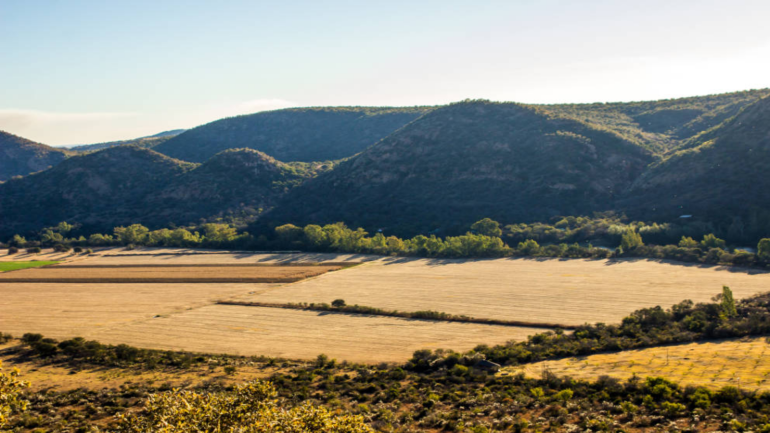The oldest asteroid that hit Earth was twice the size of the asteroid that wiped out the dinosaurs
For a long time, scientists thought that the giant asteroid that hit the Earth at the end of the Cretaceous period about 66 million years ago and killed the dinosaurs is the largest asteroid that hit the Earth in its history.
But contrary to what scientists believed, the largest giant asteroid that hit Earth may have been the asteroid that caused the Fredefort impact crater nearly two billion years ago, according to a press release issued by the University of Rochester, published on September 22 last.
Fredvoort crater eroded, making it difficult to estimate directly the size of the crater at the time of the original impact (websites)
The largest impact crater on Earth
According to the press release, about two billion years ago, a space body was launched, and scientists believe that it was an asteroid, and according to previous studies, this space body reached 15 kilometers in diameter, and its speed was at least 15 kilometers per second towards Earth. The impact occurred southwest of what is now Johannesburg in South Africa, and resulted in the largest known impact crater in the world.
According to the recent study conducted by the University of Rochester, this space body may have been much larger than thought, and had catastrophic effects on the planet, and this study - published in "The Journal of Geophysical Research" - provides They will provide a more accurate understanding of the significant impact of that space object, and allow researchers in upcoming studies to better simulate impact events on Earth and other planets.
“Understanding the structure of our largest impact on Earth is critical,” says Natalie Allen (a doctoral student at Johns Hopkins University). Allen, who is the paper's first author, adds that based on research she did when she was an undergraduate in Rochester with associate professor of Earth and Environmental Sciences Miki Nakajima; "Access to the information provided by a structure like Fredford crater is a great opportunity to test our model and our understanding of geological evidence so that we can better understand impacts on Earth and beyond."
Vreidfort has been selected as a UNESCO World Heritage Site as the largest event providing important evidence of the geological history of the Earth (UNESCO)
'Devastating' consequences
Over the course of two billion years, Fredvoort crater has eroded, making it difficult for scientists to directly estimate the size of the crater at the time of the original impact, and thus the size and velocity of the impactor that formed the crater.
According to the press release, any object with a size of 15 kilometers and traveling at a speed of 15 kilometers per second produces a crater with a diameter of 172 kilometers. However, this is much smaller than the current estimates of the Fredvoort crater. These current estimates are based on new geological evidence and measurements that estimate that the original diameter of the structure would have been between 250 and 280 kilometers at the time of the impact.
Allen, Nakajima and their colleagues ran simulations to match the size of the crater-former, and their findings showed that the impactor would have to be much larger (about 20 to 25 kilometers) and have collided at 15-20 kilometers per second to create a crater of Its size is 250 km.
This means that the impactor that formed the Vreidfort crater was larger than the asteroid that killed the dinosaurs 66 million years ago, forming the Chicslope crater. And if the Vreidfort crater was larger, and the impact was more energetic than the one that formed the Chicslope crater, the Vreidfort collider could have caused more catastrophic global consequences.
“Contrary to the Chixlop effect, the Friedfort effect did not leave a record of mass extinctions or wildfires because there were only single-celled life forms then, as there were no trees two billion years ago,” says Nakajima. However, the collider could have affected the global climate on a larger scale than the Chixlop collider did.”
Allen says that dust and aerosols from the Friedfort effect spread across the planet and block out sunlight, cooling the Earth's surface, and “this can have a devastating effect on photosynthetic organisms. After the stabilization of dust and aerosols - which could have taken anywhere from hours to a decade - and greenhouse gases such as carbon dioxide emitted by the impact may have raised the global temperature by several degrees for an extended period of time.”
Unlike the Chixlop effect, the Fredvort effect did not leave a record of mass extinctions or wildfires (Getty Images)
Long-range results of the Fredvoort collision simulation
The simulations also allowed researchers to study the material that was scattered as a result of the impact and the distance that the material traveled from the hole, and this information can be used to determine the geographical locations of land masses billions of years ago.
For example, previous research determined that ejecta scattered as a result of the impact reached present-day Karelia in Russia, and using their model, the researchers discovered that two billion years ago the landmass containing Karelia was only 2,000 to 2,500 kilometers away from the site of the Fredevoort impact crater In South Africa, it is far less than the distance between the two regions today.
“It’s very difficult to locate the landmasses from long ago,” says Allen, and the best current simulations have re-mapped the history of landmass for only close to a billion years, and the uncertainties grow the longer in the past.
The mapping of these layers of ejected matter, which the researchers demonstrated in the recent study, may allow researchers to test their models and help complement the mapping of the prehistoric globe at which previous land mass maps stood.
Source: websites





